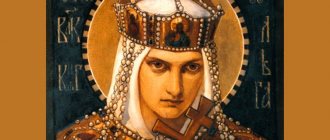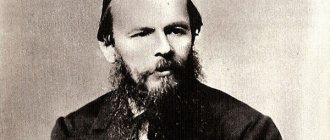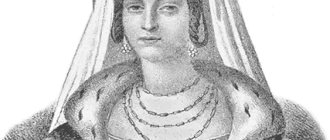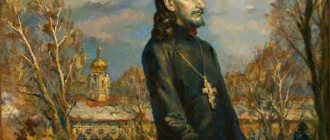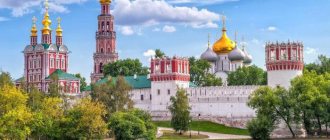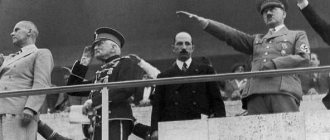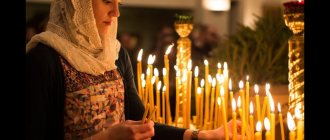Reign of Princess Olga (briefly)
After taking revenge on the Drevlyans for the murder of her husband, Prince Igor of Kyiv, his wife Princess Olga took over the rule of Kievan Rus, since Svyatoslav her son was still small.
However, most historians believe that even after Svyatoslav actually ascended the throne, the wise princess remained the ruler of the Slavic land. This is due to the fact that her son devoted most of his time to military campaigns, leaving the rule of the state to his mother. Duchess Olga
Transformations of Princess Olga
Ancient chronicles tell us about Olga’s tireless walks across Russian lands to build the economic and political life of Kievan Rus. In the Pskov and Novgorod lands, the princess established the so-called system of “pogosts” - centers of exchange and trade, in which the process of collecting taxes regularly took place. Later, temples began to be built in graveyards.
During Olga's reign, Rus' strengthened and grew. New cities were built, surrounded by high stone and oak defensive walls. The residence of the princess herself was in Vyshgorod, which was the first stone buildings in Kyiv (country tower and Olga's palace), surrounded by a loyal squad. The princess carefully watched how the lands that were collected in Rus' by Oleg and Igor were being developed.
Reform activities of Princess Olga
In addition, Olga became famous for her significant reform activities. Historians consider its main unspoken reform to be a soft attitude and the spread of the Christian faith. On Slavic soil, it was under Olga that the churches of St. Sophia and St. Nicholas appeared, as well as the church in Vitebsk (Annunciation of the Virgin Mary). According to legend, on the Pskov River, Olga’s birthplace, the princess built the city of Pskov. The Church of the Life-Giving Holy Trinity was also erected in the same land.
Princess Olga tried to introduce her son Svyatoslav to the Christian faith. However, he was only angry with his mother, remaining a pagan until the end of his life. At the same time, Svyatoslav did not prohibit Christianity in Rus' and allowed those who wanted to be baptized.
According to the chronicles, it was Svyatoslav who, after the death of Igor, began to rule the state of Kievan Rus. But the date of his sole rule is rather arbitrary precisely because most of the rule was carried out by his mother.
In 968, Kievan Rus was first attacked by the Pechenegs when Svyatoslav was on campaign. Together with her grandchildren, Grand Duchess Olga locked herself in Kyiv and held a siege. Svyatoslav, who soon returned from Bulgaria, lifted the siege and tried to set off again, but was stopped by his sick mother, who persuaded him to wait until her death. Three days later, on July 11, 969, Olga died.
Olga (945-962) |
| Suppression of the Drevlyan uprising |
| Introduction of lessons and graveyards |
| Development of the diplomatic service |
| Adoption of Christianity in Byzantium |
Video lecture: a brief history of the reign of Princess Olga
Check yourself! Test on the topic: the reign of Princess Olga
Marriage
Igor's acquaintance with his future wife is also shrouded in a lot of inaccuracies and mysteries. The “Life” says that the future Princess Olga, whose brief biography is sometimes contradictory in different sources, met her future husband in Pskov, where the prince was hunting. He needed to get across the river, and when he saw the boat, Igor got into it. Afterwards the prince discovered that his ferryman was a beautiful girl. She refused all of her passenger's advances. And when the time came to choose a bride for the prince, he remembered the girl in the boat and sent messengers for her with a marriage proposal. This is how Olga became the wife of the Russian Grand Duke. The Princess of Kiev, whose brief biography has since been traced more clearly, was a good and wise wife. Soon she gave birth to Igor’s son, Svyatoslav.
Test on the topic: “The Reign of Princess Olga”
Time limit: 0
Navigation (job numbers only)
0 of 4 tasks completed
Questions:
- 1
- 2
- 3
- 4
Information
Test on the topic: “The Reign of Princess Olga”
You have already taken the test before. You can't start it again.
The test is loading...
You must log in or register in order to begin the test.
You must complete the following tests to start this one:
results
Correct answers: 0 out of 4
Your time:
Time is over
You scored 0 out of 0 points (0)
Categories
- No category 0%
- If you have: 4 points - excellent knowledge of the topic If you have: 3 points - good knowledge of the topic If you have: 2 points - satisfactory knowledge of the topic If you have: less than 2 points - poor knowledge of the topic
- 1
- 2
- 3
- 4
- With answer
- With a viewing mark
- Task 1 of 4
1.
Indicate the year the reign of Princess Olga began?
Right
Wrong
- Task 2 of 4
2.
Indicate the year the reign of Princess Olga ended
Right
Wrong
- Task 3 of 4
3.
Which prince was the husband of Princess Olga?
Right
Wrong
- Task 4 of 4
Murder of Prince Igor
Prince Igor was a great conqueror; he constantly raided neighboring lands with his squad, collecting tribute from weak tribes. One of these campaigns became fatal for the Russian prince. In 945, Igor and his retinue went to the neighboring Drevlyans for the due tribute. Having taken a lot of wealth, destroyed villages and abused the local population, the Russians went home. However, on the way back, the prince with a small number of soldiers decided to return and again plunder the Drevlyan lands. But the local men, making sure that the prince was coming with a small army, attacked him and killed him.
Family and personal life
Having married Igor , Olga had her only son, Svyatoslav . Having been widowed relatively early, she did not strive to start a new family - she rejected the proposals of both the semi-wild Drevlyan Mal and Constantine, the emperor from the Macedonian dynasty. Olga constantly tried to convert her son to the Christian faith, but her efforts did not bear fruit. Svyatoslav, being a convinced pagan, did not interfere with Christians, but mocked them and was angry with his mother. Olga could only pray for the whole family.
With son Svyatoslav
Biography
- 938 - birth of the son Svyatoslav .
- 945 - Olga’s husband Igor went to collect tribute from the Drevlyan tribe, on the way back he decided that he had collected little, and with a small part of the squad returned to the Drevlyan capital Iskorosten , where he was killed by indignant local residents. After which 20 noble people went to Kyiv to report the death of Igor, and at the same time marry the widow to their prince Mal. Olga listened to the news calmly with the condition that the official ceremony would take place the next day and one should prepare for it: when they come for the ambassadors, one must demand that the servants carry them in the boat on which they arrived (so that the residents of Kyiv will feel how high-born a person is being offered to her get married). At night, a deep hole was dug, into which they threw the matchmakers they brought along with the boat, after which they buried the crippled alive. This was Olga's first revenge. Immediately, the widowed princess sent messengers to Mal with a demand to send the “best husbands” to give a fitting celebration to the engagement. The naive Drevlyans arrived, they heated a bathhouse for the guests of honor, when they went to wash, they were locked up and burned alive. So Olga took revenge a second time. The angry woman did not calm down at this, she headed to Iskorosten, notifying that she wanted, according to custom, to hold a funeral feast (funeral) for her husband and asking to prepare more mead (intoxicating drinks) for the ceremony. Having gathered more Drevlyans, she mourned Igor and began to drink those present. And when everyone was drunk enough, she ordered her guards to kill them, which they did, slaughtering 5,000 people . This was her third revenge.
- 946 - Olga gathered an army and went with it against the Drevlyans . The Kyivians won the battle of Iskorosten; the retreating enemy locked themselves in the city. The siege continued unsuccessfully throughout the summer. Then the princess offered to give her a ransom so that she would leave. 3 doves and 3 sparrows from each household were to serve as ransom. The trusting Drevlyans were glad that the price was such a small price and they delivered the birds. Olga ordered to tie a smoldering tinder to each bird and release them before sunset. The birds flew to their dovecotes, under roofs and haylofts, and a few hours later the city was in flames. This was the fourth and final revenge.
- 946 – beginning of tax reform . Olga established a procedure for collecting tribute from lands subordinate to Kyiv.
- 947 - administrative reform . The princess established the so-called graveyards (places for the then administration and merchants to stay), which later became the centers of territorial units.
- 955 – adoption of Christianity . Olga went to Constantinople (Constantinople) to visit Emperor Constantine Porphyrogenitus , who liked her so much that he began to hint at marriage. To which the princess explained that she was a pagan. Then the crown bearer quickly organized a baptismal ceremony and became the godfather of Elena (Olga’s Christian name). The convert received an official proposal from the emperor and diplomatically refused, citing that the daughter could not marry her father in Christ. Konstantin could only recognize her extraordinary intelligence and cunning.
- 955 – birth of Yaropolk .
- 956 – birth of grandson Oleg .
- 957 (September-October) - second visit to Constantinople .
- 959 - ambassadors to the German king Otto with a request to send a bishop to convert the people of Kiev to Christianity.
- 960 – birth of grandson Vladimir .
- May 11, 960 - consecration of the Church of St. Sophia (the wooden church burned down, in its place the St. Sophia Cathedral, built under Yaroslav the Wise).
- 962 - failure in Christianization , Bishop Adalbert fled from Kiev, some of his companions were killed.
- 968 – Pecheneg raid and siege of Kiev . Olga's son Svyatoslav waged a war against the Bulgarian kingdom and was in Pereyaslavets-on-the-Danube. At this time, the Pechenegs, having secured an agreement with the Romans (Constantinople), took advantage of the absence of the prince and besieged the capital. Olga and her grandchildren were in the city where the famine began. The besieged managed to convey the news to Svyatoslav, who returned very quickly for that time and defeated the enemy.
- 969 – Olga’s illness.
- July 11, 969 – death . Olga bequeathed not to hold a funeral feast for her according to pagan rules. She was buried according to Christian rites.
↑ Princess Olga and Orthodoxy
“From an early age, Olga searched with wisdom for what is best in this world, and found a pearl of great value—Christ.” The princess converted to Orthodoxy and became the first Christian ruler in Rus'.
Historians argue where she accepted the Orthodox faith, in Kyiv or Constantinople? Most likely, in Kyiv she only became acquainted with Christianity, and received direct baptism in Byzantium, where she was accompanied by the Kiev priest Gregory.
The Byzantine Emperor himself became the godfather of the Russian princess. This state of affairs sharply increased the prestige of Kyiv and elevated the princess among other representatives of other states. It's worth a lot to be the godson of the Byzantine Emperor. Her baptism did not entail the introduction of Christianity in Rus', but her grandson, Vladimir Svyatoslavovich, will continue the work he started.
Olga is the first Russian saint. It was from her that Orthodoxy came to Rus'. Her name will forever go down in the history of our country as the name of a heroine woman who sincerely loved her husband, her Motherland and her people.
Revenge on the Drevlyans
Having learned about the death of her husband at the hands of the Drevlyans, Olga grieved for a long time. The Princess of Kiev, whose brief biography is described in The Tale of Bygone Years, turned out to be a wise wife and ruler. According to the customs of that time, blood feud was acceptable. Naturally, Olga could not bypass this tradition. Having gathered a squad, She began to wait. Soon, ambassadors from the Drevlyans came with a wedding proposal for the sake of uniting the Russian and Drevlyan lands. The princess agreed - this was her revenge.
The gullible Drevlyans believed her, entered the capital, but were captured, thrown into a hole and covered with earth. Thus, some of the bravest and bravest Drevlyans were destroyed. The second batch of ambassadors was also killed by cunning - they were burned in a bathhouse. When Olga and her squad approached the gates of Iskorosten, the main city of the Drevlyans, under the pretext of holding a funeral feast (funeral) for the prince, she drugged her enemies, and the squad chopped them up. According to chroniclers, about five thousand Drevlyans died then.
In 946, the princess and her army went to the Drevlyan lands, destroyed them, collected taxes and established a mandatory, fixed tax, but she never managed to occupy Iskorosten. The city was impregnable. Then Olga burned the city to the ground with the help of pigeons and sparrows, tying burning cloth to their legs. Schoolchildren are told who Princess Olga is. A short biography for elementary school children omits the full story of revenge. Mainly attention is paid to the years of her reign and the adoption of the Christian faith.
Features of the biography
The history of Russia in the first half of the 10th century is poorly documented. Information about Princess Olga is brief and contradictory. None of the chronicles gives her date of birth.
Rice. 1. Princess Olga.
The Degree Book of the 16th century contains a statement that Olga died at the age of 80, therefore, the date of her birth dates back to the last decade of the 9th century. A number of historians believe that she was born in 893 or 894, and in 903 she was already married. These dates contradict the fact that her son Svyatoslav was born around 940, that is, when the princess reached 50 years of age. Historians of the 20th century, for example, academician Boris Rybakov, suggested that the princess was born around 920.
The earliest ancient Russian chronicle, that is, “The Tale of Bygone Years,” reports that Olga was born not far from Pskov, in the village of Vybuty. Some historians, for example, D. Ilovaisky, suggested that she was born in Bulgaria, in the city of Pliska.
Rice. 2. Princess Olga 945.
Foreign and domestic policy
In 945, during the collection of tribute, Olga's husband was killed by representatives of the Drevlyan tribe, so one of the main events of her reign was revenge for him. She besieged and burned the capital of the Drevlyans - the city of Iskorosten in 946. The consequence of the conflict with the Drevlyans was a change in the procedure for collecting tribute in favor of the Kyiv prince:
- Its dimensions have been established - quitrents.
- Charters have been introduced, that is, the frequency of payments.
- In the subject lands, the position of tiun, a representative of the princely administration, was introduced.
- Cemeteries appeared, that is, places for collecting tribute.
During the reign of the princess, stone construction began in Rus', and a stone palace was built in Kyiv.
There were few foreign policy events under Olga. In 957, she was baptized in Constantinople, and in 961, the first Christian bishop, Adalbert, arrived in Kyiv from Germany.
Rice. 3. Rus' in the 10th century.
Project on the topic: “Rulers of Ancient Rus' - Princess Olga” for 4th grade.
Project goal: Find information about the life of the ruler of Ancient Russia - Princess Olga of Kiev, her short biography.
Learn about her reforms and the path to Christianity. Prepare a presentation on the subject “The World Around You”, write a report or message. Present a story to schoolchildren, answer questions, defend a project. Project plan:
- Introduction. Origin.
- Beginning of reign
- Olga and the Drevlyans
- Baptism
- Conclusion
- Example of a finished presentation
